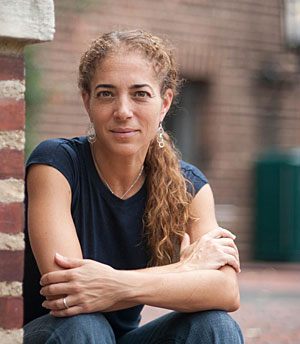The clear turquoise waters and sweet reggae melodies that grace Jamaica Tourist Board commercials tend to dominate the United States’ image of the Caribbean nation. “When people here think about Jamaica,” says Associate Professor of Anthropology Deborah Thomas, “they’re usually thinking about their holidays in Montego Bay.” Belied by these ads is the crisis of violence that is a major cause of anxiety for Jamaicans. The country’s per capita murder rate is among the top five in the world, rivaled only by South Africa and Colombia.
The crisis hit Thomas especially close to home during the debut of her first book, Modern Blackness: Nationalism, Globalization, and the Politics of Culture in Jamaica. While she had been researching this exploration of the relationship between the performing arts and political nationalism in Jamaica, she grew close to a rural hillside community not far from Kingston. On the day of her first book reading, she saw a newspaper article about gang wars that were plaguing the once peaceful community. She discovered some of the resident children she had worked with were involved, and that a good friend— someone these children looked up to—had been killed.
Thomas was puzzled by the violence. She knew that most of the time gang wars in Jamaica are mapped on to political violence, but in this community residents had traditionally lived side by side without issue despite identifying with opposing parties—even within individual families. “I wanted to find out why this usually peaceful community was being pulled into this situation and what people expected the end game to be,” Thomas says.
The result of Thomas’ investigation is her recently published book Exceptional Violence: Embodied Citizenship in Transnational Jamaica. In it, she analyzes violence in Jamaica through a variety of contexts, including how citizenship in the country has been defined over time, notions of respectability, practices of punishment and discipline during slavery, transnationalism, and Jamaican nationalism and cultural policy. Thomas’ conclusions argue against the idea, prevalent in Jamaican media and lay discourse, of the nation having a “culture of violence.”
“By documenting a deep structural history behind this violence,” Thomas says, “I hope to counter thinking that frames it as though it’s passed down like genetic material from one generation to the next.”
The gang wars, for example, have a precedent in the colonial era. As political parties developed in post-independence Jamaica, politicians relied on gang leaders, “dons” in local parlance, to deliver votes by strong-arming their neighborhoods. In return, these neighborhoods were given government contracts, arms, and protection from the law, and the “dons,” in effect, exercised juridical and social control over their neighborhoods, dubbed “garrison communities” for their strict allegiance to one of Jamaica’s two main political parties. Gang violence is frequently the result of turf wars fought between garrison communities—wars that have also splintered rivaling groups within and between these communities.
Thomas found that this relationship between geography and political authority is paralleled in Jamaican history by the relationships between slaves, overseers and estate owners, particularly in relation to the customary practice of cultivating estate lands for personal use (and for sale in markets). “Within the context of internal conflict related to these provision grounds,” she explains, “slaves linked a sense of juridical authority to the land on which they lived and the grounds they were given access to cultivate. This link –forged between land, customary rights and the practice of going to the ‘big man’ for conflict resolution—provided a template for developments during the nationalist period.”
What Thomas calls “performative” or “spectacular” violence—such as nailing a victim to a cross or exhuming a body and shooting it again—also has roots in the colonial era. These demonstrative dimensions, she found, are mirrored in the kinds of punishments that colonists developed to deter slaves from rebelling. “Cutting off someone’s head and sticking it on a pole at the entrance to a plantation is equally performative, spectacular and gross,” Thomas says, “yet we don’t talk about colonial plantation owners as having a ‘culture of violence.’ But we should because then we can see that some of the kinds of violence we’re seeing today are not a crazy cultural pathology but rather a legacy of colonialism. ”
Beyond colonialism, Exceptional Violence examines how nationalist discourse, particularly ideas about what makes for a respectable Jamaican citizen, influences violence. Nationalist leaders, Thomas explains, were trying to socialize the Jamaican citizenry into a Creole multiracial nationalism that idealized the image of the ‘noble peasant.’ “Good citizens,” she says, “went to the Anglican Church, owned and tended a plot of land, sent their kids to school, and valued colonial British culture.” But as a group that openly and vocally rejected these ideas and pledged allegiance to Africa, Rastafari were frequently a target of state harassment and violence. The suspicion with which this group is regarded endures even today and is the subject of a documentary film Thomas created with John L. Jackson, Jr., Richard Perry University Professor of Communication and Anthropology, and Junior “Gabu” Wedderburn, lead drummer with Broadway’s The Lion King and artistic director of Ancient Vibrations.
Exceptional Violence also considers Jamaica as a transnational space, in terms of both the British empire-building of the past and of the Jamaican diaspora’s migratory trajectories today. For example, Thomas found that shortly before the country’s independence 1962, Great Britain finally established an office devoted to colonial development and welfare. It was headed by a sociologist from Liverpool who worked with scholars in the U.S. to explore the relationship between poverty, family structure and barriers to development for black populations. These ideas lived on in the ways Jamaicans thought about race, development and disfunctionality. Nowadays, Thomas says, the defining of citizenship, family structure, and gendered modes of interacting in the world is being shaped by contemporary transnational situations, such as migration.
“By directing our attention globally,” Thomas says, “we can stop thinking narrowly about violence as a localized pathology and pinpoint the actors, processes and institutions that create, maintain and reproduce it.”



